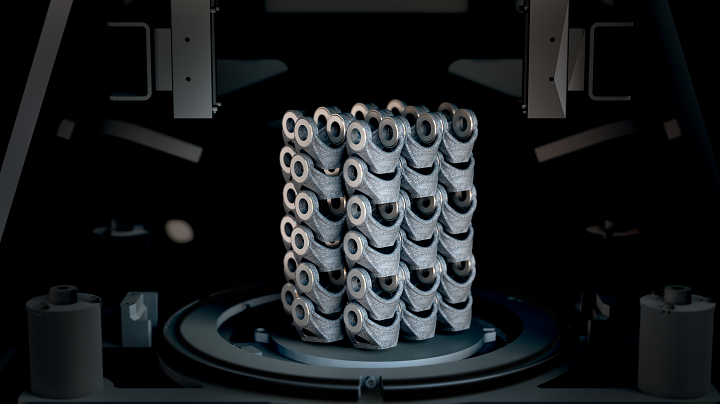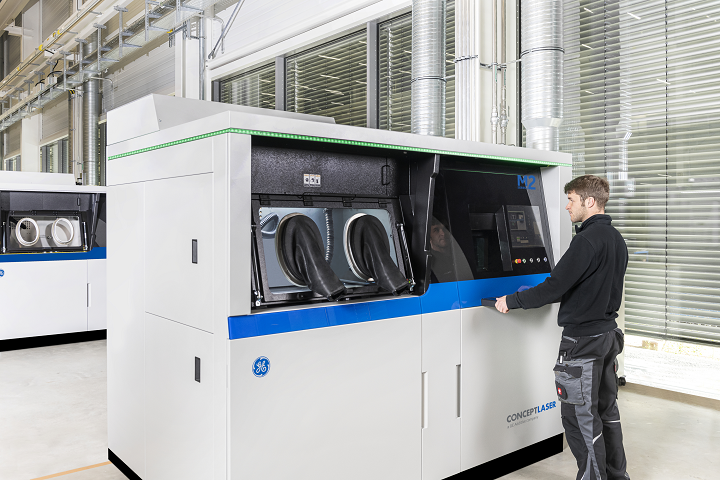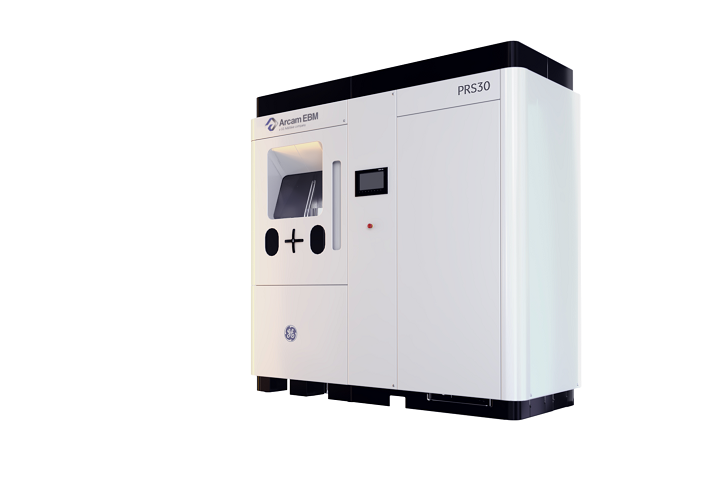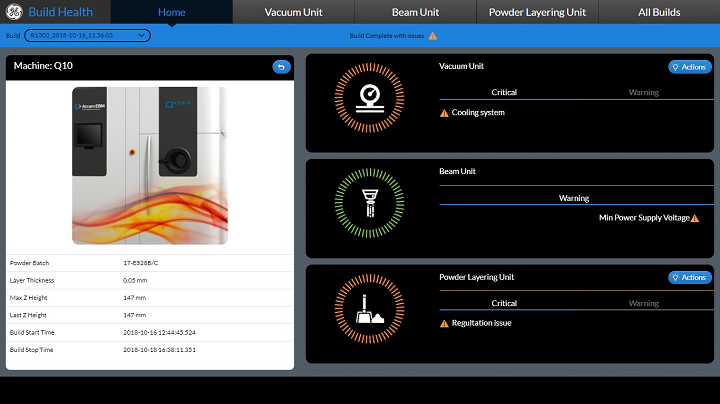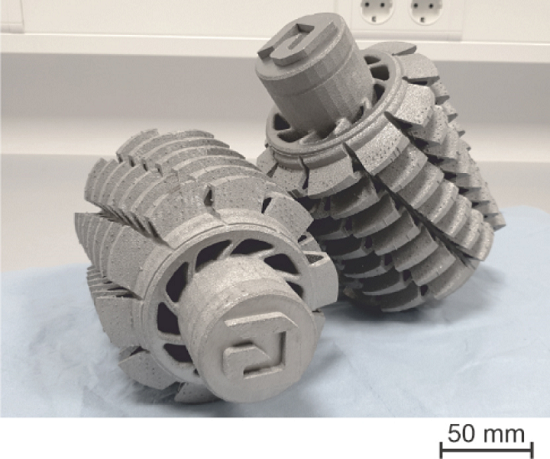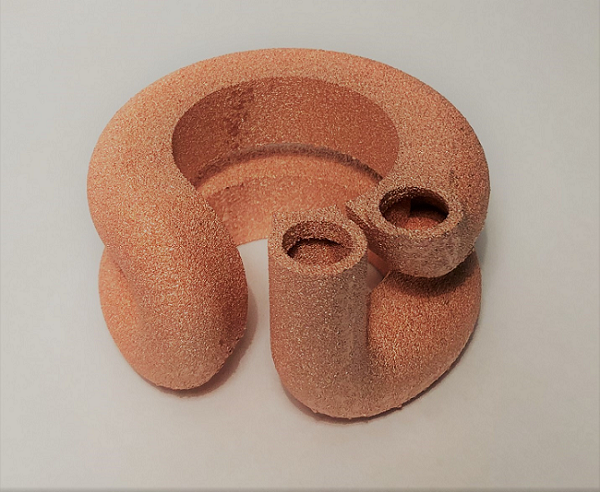This week is formnext, which means we’ve been receiving plenty of announcements of the newest 3D printing systems, materials, and partnerships. We’ve received a slew of announcements from GE Additive about all of the innovations they brought to the event, starting with the latest addition to the Arcam EBM Spectra line – the new Arcam EBM Spectra L 3D printer.
The Spectra L supports grade 5 and grade 23 Ti6Al4V, with support for pure copper coming next year, and is great for large titanium applications that you can’t complete with a laser.
 The system has increased productivity to meet higher demand, particularly in the aerospace field, which also helped to reduce cost per part by 10%. Featuring an integrated system architecture, new automation features and machine health analytics, and improved material properties, the Spectra L also delivers a 13% increase in build volume (350 x 430 mm) and a 20% increase in build speed when compared to the Arcam EBM Q20plus.
The system has increased productivity to meet higher demand, particularly in the aerospace field, which also helped to reduce cost per part by 10%. Featuring an integrated system architecture, new automation features and machine health analytics, and improved material properties, the Spectra L also delivers a 13% increase in build volume (350 x 430 mm) and a 20% increase in build speed when compared to the Arcam EBM Q20plus.
“The Spectra L is perfectly suited to those customers on the brink of, or those who have already begun to industrialize additive into their business. When we were developing the system feedback in particular from our aerospace industry customers centered on reliability, repeatability and automation, but increasingly – as they begin to scale their fleets of additive machines – also the need for process and machine health analytics and an integrated system architecture,” said Karl Lindblom, the general manager for GE Additive Arcam EBM.
The system has improved auto beam calibration, which offers a more accurate beam and consistent material properties, and features enhanced powder handling, advanced data analytics, and a standardized IoT interface, which helps users facilitate these analytics by connecting multiple systems.
The new Spectra L is available for order now, and delivery is expected at the end of Q1 2020.
 Another new system GE Additive introduced at formnext this week is the new Concept Laser M2 Series 5, available for order now, with delivery in Q1 of 2020. The robust machine was designed for users looking to, as the company put it, “unlock the potential of volume additive production.”
Another new system GE Additive introduced at formnext this week is the new Concept Laser M2 Series 5, available for order now, with delivery in Q1 of 2020. The robust machine was designed for users looking to, as the company put it, “unlock the potential of volume additive production.”
“As our customers evolve and start to ramp up high volume production, we will also continue to evolve our machine portfolio to meet their needs for repeatability, usability and quality. Over the past year, teams from GE Additive have worked closely with colleagues at GE Aviation – which operates a fleet of M2s – to get direct feedback. Co-located teams collaborated on the critical characteristics needed for the next iteration of the M2 and to make a good part, but also on input on the mechanical operations, performance and productivity of the machine, and on improvements in reliability and quality,” stated Chris Schuppe, general manager – engineering, GE Additive.
This work included machine design, system and component review, and an extended testing period as well.
As the aerospace and medical industries, which have very exacting standards and regulations, move to serial additive production, this iteration of the M2 is a good fit for both, as it stands up to their high part quality and consistency expectations.
The M2 Series 5 offers multiple new benefits and features, such as:
- upgraded gas flow system
- 2x increased build sped
- new optical cooling with over ten internal sensors
- dual laser system
- improved build plate consistency
- up to 20% finer feature resolution
- safety system with better filter change and inerted sieving and powder exchange
- increased build volume thanks to increased surface area
- improved part quality with better stitching & reduced surface roughness
- upgraded software and system design
GE Additive also introduced its new automated powder recovery system, the Arcam PRS 30, at formnext, which is compatible with the new Spectra L 3D printer.
The Arcam PRS 30 creates a closed system, so that powder exposure can be contained from industrial AM operators. It features automated blasting and cleaning of the blast chamber, self-diagnostics, exchangeable cyclone and tubes, and a new interface. According to Lindblom:
“Customers shifting to serial additive production inceasingly look to us to take and integrated, system-wide approach, and that usually includes guidance on safe and efficient powder handling.
“We are able to respond quickly to customer demands with solutions such as the Arcam PRS-30, by relying both on extensive collective experience with powder manufacturing and handling, and expertise in industrial automation and EHS across GE Additive.”
You can order the Arcam PRS 30 now, and deliveries are slated to begin in Q2 2020.
Another announcement that GE Additive revealed at formnext is the launch of its Arcam EBM Build Performance Analyzer. In this new suite of machine health data analytics, machine sensors collect data during 3D printing, which can then be analyzed. The software, which can be run on a laptop as well as the 3D printer, then gives users a holistic view of the machine’s health and process.
The team that developed the software examined the parameters of over 350 log files and applied machine learning, so that the Build Performance Analyzer can find important trends and give customers predictive data so that they can make more informed decisions. Lindblom said that,
“Being able to access and then make decisions based on real-time data analysis is another way we put our users in control of their systems.
“Whether they operate a single machine or entire fleets of our systems, the ability able to receive, interpret and use data smartly can save both time and cost.”
The Arcam EBM Build Performance Analyzer will be released next month to Arcam EBM Q10 and Q10plus customers, and then to Q20 and Q20plus customers in Q1 2020; Arcam EBM Spectra customers will have their chance through Q2 and Q3.
The final innovation GE Additive announced at formnext this week is the 2020 general release of development material, or D-material, support for highly-alloyed tool steel and pure copper.
“This general release of D-material support for pure copper and tool steel is an exciting development and opens up EBM to wider range of industries and applications,” Lindblom said.
“We have opted to take an open, collaborative approach and will review feedback from customer using the D-material, and gauge their long-term interest, before considering how we approach industrializing the materials.”
The decision to add tool steel and copper is in response to customer interest, and the D-material describes, according to GE Additive, “the maturity of process parameters for a specific material of family of materials.”
EBM technology can produce electrically pure copper in geometries that conventional manufacturing just can’t achieve. Because process steps like soldering and joining are negated with 3D printing, users can create a higher-performance component in a more cost-effective manner.
Complex geometries in pure copper that still maintain high thermal and electrical conductivity have plenty of applications in automotive and electrical connectors. GE Additive AddWorks will offer users support and guidance for the correct process parameters for these D-materials.
3DPrint.com is on the floor at formnext all week, so stay tuned for more announcements from the event in Frankfurt!
Discuss this and other 3D printing topics at 3DPrintBoard.com or share your thoughts below.
[Images provided by GE Additive]Subscribe to Our Email Newsletter
Stay up-to-date on all the latest news from the 3D printing industry and receive information and offers from third party vendors.
Print Services
Upload your 3D Models and get them printed quickly and efficiently.
You May Also Like
Heating Up: 3D Systems’ Scott Green Discusses 3D Printing’s Potential in the Data Center Industry
The relentless rise of NVIDIA, the steadily increasing pledges of major private and public investments in national infrastructure projects around the world, and the general cultural obsession with AI have...
3DPOD 260: John Hart on VulcanForms, MIT, Desktop Metal and More
John Hart is a Professor at MIT; he´s also the director of the Laboratory for Manufacturing and Productivity as well as the director of the Center for Advanced Production Technologies....
Etsy Design Rule Change Reduces Selection of 3D Printed Goods
Online marketplace Etsy has implemented a rule change requiring all 3D printed goods on the site to be original designs. The update to the site’s Creativity Standards states, ¨Items produced using...
E-Beam OEM Wayland Additive Partners with USC Racing to 3D Print Titanium Exhaust Collector
Every year, standards organization SAE International holds a competition called Formula SAE, in which students from both undergraduate and graduate programs design, build, and race small formula-style race cars. For...



